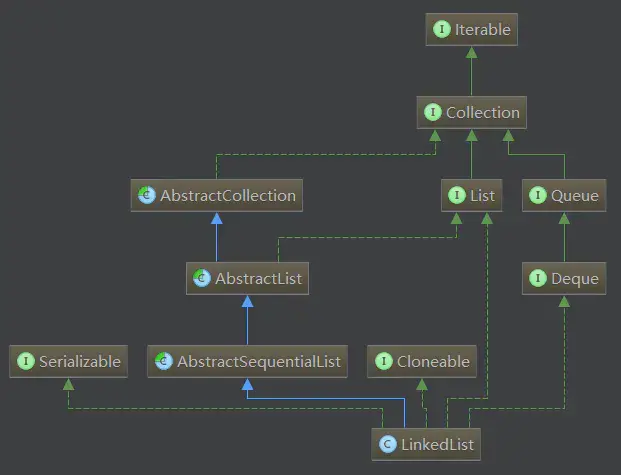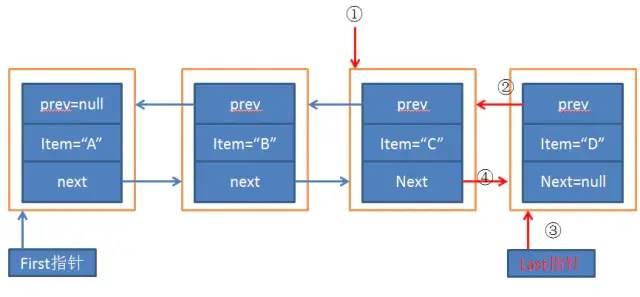前言
日常开发中,集合是我们经常用到的一种数据结构,当然,集合也并不是一种,也没有所谓的最好的集合,只有最适合的;
当然作为高级程序员,我们不仅仅要会用,还要了解其中的原理;
今天我们就来聊聊LinkedList底层实现和原理
一、LinkedList介绍
- public class LinkedList<E>
- extends AbstractSequentialList<E>
- implements List<E>, Deque<E>, Cloneable, java.io.Serializable
- {
- //长度
- transient int size = 0;
- //指向头结点
- transient Node<E> first;
- //指向尾结点
- transient Node<E> last;
- }
1、LinkedList概述
LinkedList同时实现了List接口和Deque对口,也就是收它既可以看作一个顺序容器,又可以看作一个队列(Queue),同时又可以看作一个栈(stack);
这样看来,linkedList简直就是无敌的,当你需要使用栈或者队列时,可以考虑用LinkedList,一方面是因为Java官方已经声明不建议使用Stack类,更遗憾的是,Java里根本没有一个叫做Queue的类(只是一个接口的名字);
关于栈或队列,现在首选是ArrayDeque,它有着比LinkedList(当作栈或队列使用时)更好的性能;
LinkedList的实现方式决定了所有跟下表有关的操作都是线性时间,而在首段或者末尾删除元素只需要常数时间。为追求效率LinkedList没有实现同步(synchronized),如果需要多个线程并发访问,可以先采用Collections.synchronizedList()方法对其进行包装
2、数据结构
继承关系
- java.lang.Object
- java.util.AbstractCollection<E>
- java.util.AbstractList<E>
- java.util.AbstractSequentialList<E>
- java.util.LinkedList<E>
实现接口
- Serializable, Cloneable, Iterable<E>, Collection<E>, Deque<E>, List<E>, Queue<E>
基本属性
- transient int size = 0; //LinkedList中存放的元素个数
- transient Node
first; //头节点 - transient Node
last; //尾节点 - Collection 接口:Collection接口是所有集合类的根节点,Collection表示一种规则,所有实现了Collection接口的类遵循这种规则
继承的类与实现的接口
- List 接口:List是Collection的子接口,它是一个元素有序(按照插入的顺序维护元素顺序)、可重复、可以为null的集合
- AbstractCollection 类:Collection接口的骨架实现类,最小化实现了Collection接口所需要实现的工作量
- AbstractList 类:List接口的骨架实现类,最小化实现了List接口所需要实现的工作量
- Cloneable 接口:实现了该接口的类可以显示的调用Object.clone()方法,合法的对该类实例进行字段复制,如果没有实现Cloneable接口的实例上调用Obejct.clone()方法,会抛出CloneNotSupportException异常。正常情况下,实现了Cloneable接口的类会以公共方法重写Object.clone()
- Serializable 接口:实现了该接口标示了类可以被序列化和反序列化,具体的 查询序列化详解
- Deque 接口:Deque定义了一个线性Collection,支持在两端插入和删除元素,Deque实际是“double ended queue(双端队列)”的简称,大多数Deque接口的实现都不会限制元素的数量,但是这个队列既支持有容量限制的实现,也支持没有容量限制的实现,比如LinkedList就是有容量限制的实现,其最大的容量为Integer.MAX_VALUE
- AbstractSequentialList 类:提供了List接口的骨干实现,最大限度地减少了实现受“连续访问”数据存储(如链表)支持的此接口所需的工作,对于随机访问数据(如数组),应该优先使用 AbstractList,而不是使用AbstractSequentailList类
二、底层源码分析
LinkedList是通过双向链表去实现的,既然是链表实现那么它的随机访问效率比ArrayList要低,顺序访问的效率要比较的高。每个节点都有一个前驱(之前前面节点的指针)和一个后继(指向后面节点的指针)
效果如下图:
源码标注如下:
- public class LinkedList<E>extends AbstractSequentialList<E>
- implements List<E>, Deque<E>, Cloneable, java.io.Serializable
- {
- transient int size = 0; //LinkedList中存放的元素个数
- transient Node<E> first; //头节点
- transient Node<E> last; //尾节点
- //构造方法,创建一个空的列表
- public LinkedList() {
- }
- //将一个指定的集合添加到LinkedList中,先完成初始化,在调用添加操作
- public LinkedList(Collection<? extends E> c) {
- this();
- addAll(c);
- }
- //插入头节点
- private void linkFirst(E e) {
- final Node<E> f = first; //将头节点赋值给f节点
- //new 一个新的节点,此节点的data = e , pre = null , next - > f
- final Node<E> newNode = new Node<>(null, e, f);
- first = newNode; //将新创建的节点地址复制给first
- if (f == null) //f == null,表示此时LinkedList为空
- last = newNode; //将新创建的节点赋值给last
- else
- f.prev = newNode; //否则f.前驱指向newNode
- size++;
- modCount++;
- }
- //插入尾节点
- void linkLast(E e) {
- final Node<E> l = last;
- final Node<E> newNode = new Node<>(l, e, null);
- last = newNode;
- if (l == null)
- first = newNode;
- else
- l.next = newNode;
- size++;
- modCount++;
- }
- //在succ节点前插入e节点,并修改各个节点之间的前驱后继
- void linkBefore(E e, Node<E> succ) {
- // assert succ != null;
- final Node<E> pred = succ.prev;
- final Node<E> newNode = new Node<>(pred, e, succ);
- succ.prev = newNode;
- if (pred == null)
- first = newNode;
- else
- pred.next = newNode;
- size++;
- modCount++;
- }
- //删除头节点
- private E unlinkFirst(Node<E> f) {
- // assert f == first && f != null;
- final E element = f.item;
- final Node<E> next = f.next;
- f.item = null;
- f.next = null; // help GC
- first = next;
- if (next == null)
- last = null;
- else
- next.prev = null;
- size--;
- modCount++;
- return element;
- }
- //删除尾节点
- private E unlinkLast(Node<E> l) {
- // assert l == last && l != null;
- final E element = l.item;
- final Node<E> prev = l.prev;
- l.item = null;
- l.prev = null; // help GC
- last = prev;
- if (prev == null)
- first = null;
- else
- prev.next = null;
- size--;
- modCount++;
- return element;
- }
- //删除指定节点
- E unlink(Node<E> x) {
- // assert x != null;
- final E element = x.item;
- final Node<E> next = x.next; //获取指定节点的前驱
- final Node<E> prev = x.prev; //获取指定节点的后继
- if (prev == null) {
- first = next; //如果前驱为null, 说明此节点为头节点
- } else {
- prev.next = next; //前驱结点的后继节点指向当前节点的后继节点
- x.prev = null; //当前节点的前驱置空
- }
- if (next == null) { //如果当前节点的后继节点为null ,说明此节点为尾节点
- last = prev;
- } else {
- next.prev = prev; //当前节点的后继节点的前驱指向当前节点的前驱节点
- x.next = null; //当前节点的后继置空
- }
- x.item = null; //当前节点的元素设置为null ,等待垃圾回收
- size--;
- modCount++;
- return element;
- }
- //获取LinkedList中的第一个节点信息
- public E getFirst() {
- final Node<E> f = first;
- if (f == null)
- throw new NoSuchElementException();
- return f.item;
- }
- //获取LinkedList中的最后一个节点信息
- public E getLast() {
- final Node<E> l = last;
- if (l == null)
- throw new NoSuchElementException();
- return l.item;
- }
- //删除头节点
- public E removeFirst() {
- final Node<E> f = first;
- if (f == null)
- throw new NoSuchElementException();
- return unlinkFirst(f);
- }
- //删除尾节点
- public E removeLast() {
- final Node<E> l = last;
- if (l == null)
- throw new NoSuchElementException();
- return unlinkLast(l);
- }
- //将添加的元素设置为LinkedList的头节点
- public void addFirst(E e) {
- linkFirst(e);
- }
- //将添加的元素设置为LinkedList的尾节点
- public void addLast(E e) {
- linkLast(e);
- }
- //判断LinkedList是否包含指定的元素
- public boolean contains(Object o) {
- return indexOf(o) != -1;
- }
- //返回List中元素的数量
- public int size() {
- return size;
- }
- //在LinkedList的尾部添加元素
- public boolean add(E e) {
- linkLast(e);
- return true;
- }
- //删除指定的元素
- public boolean remove(Object o) {
- if (o == null) {
- for (Node<E> x = first; x != null; x = x.next) {
- if (x.item == null) {
- unlink(x);
- return true;
- }
- }
- } else {
- for (Node<E> x = first; x != null; x = x.next) {
- if (o.equals(x.item)) {
- unlink(x);
- return true;
- }
- }
- }
- return false;
- }
- //将集合中的元素添加到List中
- public boolean addAll(Collection<? extends E> c) {
- return addAll(size, c);
- }
- //将集合中的元素全部插入到List中,并从指定的位置开始
- public boolean addAll(int index, Collection<? extends E> c) {
- checkPositionIndex(index);
- Object[] a = c.toArray(); //将集合转化为数组
- int numNew = a.length; //获取集合中元素的数量
- if (numNew == 0) //集合中没有元素,返回false
- return false;
- Node<E> pred, succ;
- if (index == size) {
- succ = null;
- pred = last;
- } else {
- succ = node(index); //获取位置为index的结点元素,并赋值给succ
- pred = succ.prev;
- }
- for (Object o : a) { //遍历数组进行插入操作。修改节点的前驱后继
- @SuppressWarnings("unchecked") E e = (E) o;
- Node<E> newNode = new Node<>(pred, e, null);
- if (pred == null)
- first = newNode;
- else
- pred.next = newNode;
- pred = newNode;
- }
- if (succ == null) {
- last = pred;
- } else {
- pred.next = succ;
- succ.prev = pred;
- }
- size += numNew;
- modCount++;
- return true;
- }
- //删除List中所有的元素
- public void clear() {
- // Clearing all of the links between nodes is "unnecessary", but:
- // - helps a generational GC if the discarded nodes inhabit
- // more than one generation
- // - is sure to free memory even if there is a reachable Iterator
- for (Node<E> x = first; x != null; ) {
- Node<E> next = x.next;
- x.item = null;
- x.next = null;
- x.prev = null;
- x = next;
- }
- first = last = null;
- size = 0;
- modCount++;
- }
- //获取指定位置的元素
- public E get(int index) {
- checkElementIndex(index);
- return node(index).item;
- }
- //将节点防止在指定的位置
- public E set(int index, E element) {
- checkElementIndex(index);
- Node<E> x = node(index);
- E oldVal = x.item;
- x.item = element;
- return oldVal;
- }
- //将节点放置在指定的位置
- public void add(int index, E element) {
- checkPositionIndex(index);
- if (index == size)
- linkLast(element);
- else
- linkBefore(element, node(index));
- }
- //删除指定位置的元素
- public E remove(int index) {
- checkElementIndex(index);
- return unlink(node(index));
- }
- //判断索引是否合法
- private boolean isElementIndex(int index) {
- return index >= 0 && index < size;
- }
- //判断位置是否合法
- private boolean isPositionIndex(int index) {
- return index >= 0 && index <= size;
- }
- //索引溢出信息
- private String outOfBoundsMsg(int index) {
- return "Index: "+index+", Size: "+size;
- }
- //检查节点是否合法
- private void checkElementIndex(int index) {
- if (!isElementIndex(index))
- throw new IndexOutOfBoundsException(outOfBoundsMsg(index));
- }
- //检查位置是否合法
- private void checkPositionIndex(int index) {
- if (!isPositionIndex(index))
- throw new IndexOutOfBoundsException(outOfBoundsMsg(index));
- }
- //返回指定位置的节点信息
- //LinkedList无法随机访问,只能通过遍历的方式找到相应的节点
- //为了提高效率,当前位置首先和元素数量的中间位置开始判断,小于中间位置,
- //从头节点开始遍历,大于中间位置从尾节点开始遍历
- Node<E> node(int index) {
- // assert isElementIndex(index);
- if (index < (size >> 1)) {
- Node<E> x = first;
- for (int i = 0; i < index; i++)
- x = x.next;
- return x;
- } else {
- Node<E> x = last;
- for (int i = size - 1; i > index; i--)
- x = x.prev;
- return x;
- }
- }
- //返回第一次出现指定元素的位置
- public int indexOf(Object o) {
- int index = 0;
- if (o == null) {
- for (Node<E> x = first; x != null; x = x.next) {
- if (x.item == null)
- return index;
- index++;
- }
- } else {
- for (Node<E> x = first; x != null; x = x.next) {
- if (o.equals(x.item))
- return index;
- index++;
- }
- }
- return -1;
- }
- //返回最后一次出现元素的位置
- public int lastIndexOf(Object o) {
- int index = size;
- if (o == null) {
- for (Node<E> x = last; x != null; x = x.prev) {
- index--;
- if (x.item == null)
- return index;
- }
- } else {
- for (Node<E> x = last; x != null; x = x.prev) {
- index--;
- if (o.equals(x.item))
- return index;
- }
- }
- return -1;
- }
- //弹出第一个元素的值
- public E peek() {
- final Node<E> f = first;
- return (f == null) ? null : f.item;
- }
- //获取第一个元素
- public E element() {
- return getFirst();
- }
- //弹出第一元素,并删除
- public E poll() {
- final Node<E> f = first;
- return (f == null) ? null : unlinkFirst(f);
- }
- //删除第一个元素
- public E remove() {
- return removeFirst();
- }
- //添加到尾部
- public boolean offer(E e) {
- return add(e);
- }
- //添加到头部
- public boolean offerFirst(E e) {
- addFirst(e);
- return true;
- }
- //插入到最后一个元素
- public boolean offerLast(E e) {
- addLast(e);
- return true;
- }
- //队列操作
- //尝试弹出第一个元素,但是不删除元素
- public E peekFirst() {
- final Node<E> f = first;
- return (f == null) ? null : f.item;
- }
- //队列操作
- //尝试弹出最后一个元素,不删除
- public E peekLast() {
- final Node<E> l = last;
- return (l == null) ? null : l.item;
- }
- //弹出第一个元素,并删除
- public E pollFirst() {
- final Node<E> f = first;
- return (f == null) ? null : unlinkFirst(f);
- }
- //弹出最后一个元素,并删除
- public E pollLast() {
- final Node<E> l = last;
- return (l == null) ? null : unlinkLast(l);
- }
- //如队列,添加到头部
- public void push(E e) {
- addFirst(e);
- }
- //出队列删除第一个节点
- public E pop() {
- return removeFirst();
- }
- //删除指定元素第一次出现的位置
- public boolean removeFirstOccurrence(Object o) {
- return remove(o);
- }
- //删除指定元素最后一次出现的位置
- public boolean removeLastOccurrence(Object o) {
- if (o == null) {
- for (Node<E> x = last; x != null; x = x.prev) {
- if (x.item == null) {
- unlink(x);
- return true;
- }
- }
- } else {
- for (Node<E> x = last; x != null; x = x.prev) {
- if (o.equals(x.item)) {
- unlink(x);
- return true;
- }
- }
- }
- return false;
- }
- //遍历方法
- public ListIterator<E> listIterator(int index) {
- checkPositionIndex(index);
- return new ListItr(index);
- }
- //内部类,实现ListIterator接口
- private class ListItr implements ListIterator<E> {
- private Node<E> lastReturned = null;
- private Node<E> next;
- private int nextIndex;
- private int expectedModCount = modCount;
- ListItr(int index) {
- // assert isPositionIndex(index);
- next = (index == size) ? null : node(index);
- nextIndex = index;
- }
- public boolean hasNext() {
- return nextIndex < size;
- }
- public E next() {
- checkForComodification();
- if (!hasNext())
- throw new NoSuchElementException();
- lastReturned = next;
- next = next.next;
- nextIndex++;
- return lastReturned.item;
- }
- public boolean hasPrevious() {
- return nextIndex > 0;
- }
- public E previous() {
- checkForComodification();
- if (!hasPrevious())
- throw new NoSuchElementException();
- lastReturned = next = (next == null) ? last : next.prev;
- nextIndex--;
- return lastReturned.item;
- }
- public int nextIndex() {
- return nextIndex;
- }
- public int previousIndex() {
- return nextIndex - 1;
- }
- public void remove() {
- checkForComodification();
- if (lastReturned == null)
- throw new IllegalStateException();
- Node<E> lastNext = lastReturned.next;
- unlink(lastReturned);
- if (next == lastReturned)
- next = lastNext;
- else
- nextIndex--;
- lastReturned = null;
- expectedModCount++;
- }
- public void set(E e) {
- if (lastReturned == null)
- throw new IllegalStateException();
- checkForComodification();
- lastReturned.item = e;
- }
- public void add(E e) {
- checkForComodification();
- lastReturned = null;
- if (next == null)
- linkLast(e);
- else
- linkBefore(e, next);
- nextIndex++;
- expectedModCount++;
- }
- final void checkForComodification() {
- if (modCount != expectedModCount)
- throw new ConcurrentModificationException();
- }
- }
- //静态内部类,创建节点
- private static class Node<E> {
- E item;
- Node<E> next;
- Node<E> prev;
- Node(Node<E> prev, E element, Node<E> next) {
- this.item = element;
- this.next = next;
- this.prev = prev;
- }
- }
- /**
- * @since 1.6
- */
- public Iterator<E> descendingIterator() {
- return new DescendingIterator();
- }
- /**
- * Adapter to provide descending iterators via ListItr.previous
- */
- private class DescendingIterator implements Iterator<E> {
- private final ListItr itr = new ListItr(size());
- public boolean hasNext() {
- return itr.hasPrevious();
- }
- public E next() {
- return itr.previous();
- }
- public void remove() {
- itr.remove();
- }
- }
- @SuppressWarnings("unchecked")
- private LinkedList<E> superClone() {
- try {
- return (LinkedList<E>) super.clone();
- } catch (CloneNotSupportedException e) {
- throw new InternalError();
- }
- }
- /**
- * Returns a shallow copy of this {@code LinkedList}. (The elements
- * themselves are not cloned.)
- *
- * @return a shallow copy of this {@code LinkedList} instance
- */
- public Object clone() {
- LinkedList<E> clone = superClone();
- // Put clone into "virgin" state
- clone.first = clone.last = null;
- clone.size = 0;
- clone.modCount = 0;
- // Initialize clone with our elements
- for (Node<E> x = first; x != null; x = x.next)
- clone.add(x.item);
- return clone;
- }
- public Object[] toArray() {
- Object[] result = new Object[size];
- int i = 0;
- for (Node<E> x = first; x != null; x = x.next)
- result[i++] = x.item;
- return result;
- }
- @SuppressWarnings("unchecked")
- public <T> T[] toArray(T[] a) {
- if (a.length < size)
- a = (T[])java.lang.reflect.Array.newInstance(
- a.getClass().getComponentType(), size);
- int i = 0;
- Object[] result = a;
- for (Node<E> x = first; x != null; x = x.next)
- result[i++] = x.item;
- if (a.length > size)
- a[size] = null;
- return a;
- }
- private static final long serialVersionUID = 876323262645176354L;
- //将对象写入到输出流中
- private void writeObject(java.io.ObjectOutputStream s)
- throws java.io.IOException {
- // Write out any hidden serialization magic
- s.defaultWriteObject();
- // Write out size
- s.writeInt(size);
- // Write out all elements in the proper order.
- for (Node<E> x = first; x != null; x = x.next)
- s.writeObject(x.item);
- }
- //从输入流中将对象读出
- @SuppressWarnings("unchecked")
- private void readObject(java.io.ObjectInputStream s)
- throws java.io.IOException, ClassNotFoundException {
- // Read in any hidden serialization magic
- s.defaultReadObject();
- // Read in size
- int size = s.readInt();
- // Read in all elements in the proper order.
- for (int i = 0; i < size; i++)
- linkLast((E)s.readObject());
- }
- }
1、构造方法
- LinkedList()
- LinkedList(Collection<? extends E> c)
LinkedList没有长度的概念,所以不存在容量不足的问题,因此不需要提供初始化大小的构造方法,因此值提供了两个方法,一个是无参构造方法,初始一个LinkedList对象,和将指定的集合元素转化为LinkedList构造方法。
2、添加节点
- public boolean add(E e) {
- linkLast(e);
- return true;
- }
- void linkLast(E e) {
- final Node<E> l = last;
- final Node<E> newNode = new Node<>(l, e, null);
- last = newNode;
- if (l == null)
- first = newNode;
- else
- l.next = newNode;
- size++;
- modCount++;
- }
通过源码可以看出添加的过程如下:
- 记录当前末尾节点,通过构造另外一个指向末尾节点的指针l
- 产生新的节点:注意的是由于是添加在链表的末尾,next是为null的
- last指向新的节点
- 这里有个判断,我的理解是判断是否为第一个元素(当l==null时,表示链表中是没有节点的),
- 那么就很好理解这个判断了,如果是第一节点,则使用first指向这个节点,若不是则当前节点的next指向新增的节点
- size增加:在上面提到的LinkedList["A","B","C"]中添加元素“D”,过程大致如图:
3、删除节点
LinkedList中提供了两个方法删除节点
- //方法1.删除指定索引上的节点
- public E remove(int index) {
- //检查索引是否正确
- checkElementIndex(index);
- //这里分为两步,第一通过索引定位到节点,第二删除节点
- return unlink(node(index));
- }
- //方法2.删除指定值的节点
- public boolean remove(Object o) {
- //判断删除的元素是否为null
- if (o == null) {
- //若是null遍历删除
- for (Node<E> x = first; x != null; x = x.next) {
- if (x.item == null) {
- unlink(x);
- return true;
- }
- }
- } else {
- //若不是遍历删除
- for (Node<E> x = first; x != null; x = x.next) {
- if (o.equals(x.item)) {
- unlink(x);
- return true;
- }
- }
- }
- return false;
- }
通过源码可以看出两个方法都是通过unlink()删除
- 获取到需要删除元素当前的值,指向它前一个节点的引用,以及指向它后一个节点的引用。
- 判断删除的是否为第一个节点,若是则first向后移动,若不是则将当前节点的前一个节点next指向当前节点的后一个节点
- 判断删除的是否为最后一个节点,若是则last向前移动,若不是则将当前节点的后一个节点的prev指向当前节点的前一个节点
- 将当前节点的值置为null
- size减少并返回删除节点的值
三、ArrayList和LinkedList区别
1.底层实现:ArrayList内部是数组实现,而LinkedList内部实现是双向链表结构;
2.接口实现:都实现了List接口,都是线性列表的实现,ArrayList实现了RandomAccess可以支持随机元素访问,而LinkedList实现了Deque可以当做队列使用;
3.性能:新增、删除元素时ArrayList需要使用到拷贝原数组,而LinkedList只需移动指针,查找元素 ArrayList支持随机元素访问,而LinkedList只能一个节点的去遍历;
4、线程安全:都是线程不安全的;
5、LinkedList下插入、删除是性能优于ArrayList,这是由于插入、删除元素时ArrayList中需要额外的开销去移动、拷贝元素(但是使用removeElements2方法所示去遍历删除是速度异常的快,这种方式的做法是从末尾开始删除,不存在移动、拷贝元素,从而速度非常快);
6.ArrayList在查询元素的性能上要由于LinkedList;
总结
LinkedList是一个功能很强大的类,可以被当作List集合,双端队列和栈来使用;LinkedList底层使用链表来保存集合中的元素,因此随机访问的性能较差,但是插入删除时性能非常的出色;
本文转载自微信公众号「Android开发编程」









































